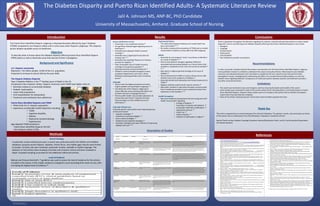More Related Content
Similar to Johnson Poster PresentatioT
Similar to Johnson Poster PresentatioT (20)
Johnson Poster PresentatioT
- 1. RESEARCH POSTER PRESENTATION DESIGN © 2012
www.PosterPresentations.com
The Puerto Rican identified Hispanic subgroup is disproportionately affected by type 2 diabetes
(T2DM) compared to non-Hispanic whites and in some cases other Hispanic subgroups. This disparity
persist despite equitable access to healthcare.
Introduction
Search Strategy
A systematic review method was used. A search was conducted within the CINAHL and PubMed
databases using key words Hispanic, diabetes, Puerto Rican, and middle aged. Results were limited
to studies <10 years old, peer-reviewed, systematic reviews, available in English language. The
abstracts of 124 articles were reviewed, 8 articles met inclusion criteria and were reviewed in
depth. Snowball sampling accounted for the additional referenced articles.
Methods
Description of Studies
Results Conclusions
Recommendations
References
Limitations
University of Massachusetts, Amherst. Graduate School of Nursing.
Jalil A. Johnson MS, ANP-BC, PhD Candidate
The Diabetes Disparity and Puerto Rican Identified Adults- A Systematic Literature Review
Background and Significance
U.S. Hispanic community
Represent > 50 million people, 14.8% of the U.S. population
Projected to increase to almost 25% by the year 2050.
The Hispanic Diabetes Disparity
Type 2 Diabetes Mellitus is the 7th leading cause of death in the US.
Compared to Non-Hispanic whites, Hispanic Americans with T2DM have higher rates of:
• Mortality related to uncontrolled diabetes
• Diabetic nephropathy
• Lower limb amputations
• And hospitalization for ketoacidosis
• Treatment and medication Non-adherence.
Puerto Rican identified Hispanics and T2DM
• PRiHs 9.6% of U.S. Hispanic population
• Experience considerable health disparities including:
• T2DM
• Cognitive disability
• Obesity
• Depressive symptomatology
• Hypertension
Age-adjusted T2DM prevalence:
Puerto Rican identified Hispanic (10.1%)
Non-Hispanic whites (5.9%).
Objective
To describe what is known about the diabetes disparity affecting Puerto Rican identified Hispanic
(PRiH) adults as well as illuminate areas that warrant further investigation.
Level of Evidence
Melnyk and Fineout-Overholt’s 16 guideline was used to assess the level of evidence for the articles
included in the review. In this model, evidence is assigned a score ascending from seven to one, with
one being the highest level of evidence.16
Access and Barriers to Care
• Citizenship is not a healthcare barrier.18
• No significant disadvantaged regarding access to
healthcare.19
• Generally have adequate health insurance
coverage.19
• Generally have a regular/particular place for
medical care.19, 21.
• Generally have equitable frequency of seeing a
provider for diabetes. 19
• Have comparable rates of health insurance
coverage to the general population.20
• Disproportionately covered by Medicaid. 21
• Tended to overuse hospital emergency rooms,
outpatient departments, and clinics, where
Medicaid-accepting providers were commonly
found.21
Language
• Tend to have the highest proportion of native
English speakers among Hispanic subgroups. 19
• Less likely than other Hispanic subgroups to
report difficulty communicating with health care
providers because of language barriers.19
• Tend to prefer health care providers (physicians &
nurses) who were fluent in Spanish and view
these providers as more credible sources of
information.25
Psychosocial factors
• The relationship between diabetes and mental health has
been well studied.26, 27
• No studies compared the prevalence of T2DM and co-morbid
mental health conditions as they affect the PRiH subgroup.
Beliefs
• Generally, do not recognize “susto” as an illness or identify it
as a cause of diabetes.32, 33
• Tend to have fatalistic thoughts regarding T2DM and
associated with perceiving diabetes as a chronic illness that
resulted in complications over time that cannot be avoided.25,
34, 35
• May report a religious/spiritual etiology as the cause of
diabetes.36
• Tend to believed that T2DM is a serious illness and are able
identify many of the symptoms of diabetes.36
• Generally identify both biomedical and herbal treatments for
T2DM.36
• Negative attitudes toward insulin may be common.36
• May prefer standard or alternative therapies recommended
from a healthcare provider (nurse or physician) rather than
traditional or folk remedies.25, 35
Health Perceptions
• May have healthcare perspectives that are incongruent with
health care providers regarding:
• Etiology of diabetes. 36
• Association of obesity with diabetes. 36
• Acceptable T2DM diet modifications. 36
• Appropriate exercise. 36
• Insulin use. 36
• Herbal remedies. 36
• Influence of spirituality or religion.36
Culturally Tailored Care
Culturally specific interventions have improved glucose
control and include:
• Linguistic strategies. 42
• Constituent involving strategies. 42
• Socio-cultural strategies. 42
• Peripheral and evidential strategies.42
• Education strategies have been effective at improving
diabetes self-care.47-44
There is agreement throughout the literature regarding the need for culturally tailored interventions to reduce health
disparities. Factors contributing to the diabetes disparity affecting Puerto Rican identified Hispanics may include:
• Biological
• Language
• Socioeconomic
• Psychosocial
• Cultural beliefs
• Poor healthcare provider concordance
In order to provide culturally tailored interventions and education for the Puerto Rican identified Hispanic subgroup,
more qualitative research is needed to understand the unique sociocultural forces influencing the poor diabetes
outcomes and individual behaviors that contribute to suboptimal self-care. Specific areas that warrant further
investigation include: investigating the relationship and affect of co-morbid mental health problems on self-care;
fatalistic views regarding diabetes; incongruence of health perceptions between patients and healthcare providers;
and other sociocultural factors.
• The search was restricted to two search engines and thus reducing the depth and breadth of the search.
• Some studies were conducted in areas of the country where there is the population is commonly known as Puerto
Rican identified Hispanic, however theses studies were not included as the authors did not identify the Hispanic
subset when they described the sample(s).
• None of the articles meeting inclusion criteria had a level of evidence greater than four.
Thank You
This work is supported by an unrestricted grant from Hluchyj Fellowship. The opinions, results, and conclusions are those
of the author, and no endorsement from the fellowship is intended or should be inferred.
Special Thanks to Dean Stephen Cavanagh (Academic Advisor/Dissertation Chair) and Dr. Cynthia Jacelon (Dissertation
Committee member)
